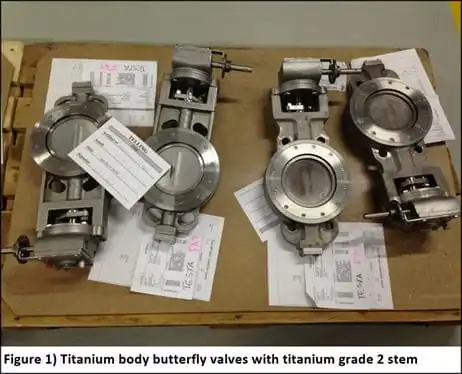

However, valves are actuated for either ease of operation or safety function. Figure 2 illustrates the pneumatic actuated butterfly valves in titanium material for sea water services.
The implemented force on the stem would be increased in case of actuation. Therefore, the stem material should be upgraded to a material with higher mechanical strength. Table 2 provides upgraded stem materials for each valve body material in case of high actuation loads.

CASE STUDY
In this situation, a pneumatic actuated butterfly valve had a MAST (Maximum Allowable Stem Torque) problem. In fact, MAST should be higher than the actuator torque. However, in this case, an 8" Class 150 (Pressure Nominal 20Barg) Carbon steel body valve was receiving a maximum torque value of 1193 ft/lb (1618 N.m) from the actuator. The MAST value of stem material in 13Cr-4Ni is less than 1618 N.M. Therefore, the following solutions were proposed and evaluated to solve this issue.
SOLUTIONS
1. Upgrading the stem material from 13Cr-4Ni to 17-4 PH: 17-4PH (17Chromium-4Nickel) material is a martensitic precipitation-hardening stainless steel which provides very high mechanical strength. This material is widely used for carbon steel body valves in the onshore sector of oil and gas. However, this material has high risk of chloride stress cracking corrosion in offshore environment. However, as can be seen in Figure 1, the stem of the valve is exposed to the environment and it was decided to avoid 17-4 PH stem material to avoid corrosion risk.
2. Reducing the air pressure in the control panel: The torque value of 1193 ft/lb (1618 N.m) is obtained through 700 kilopascals (kPa) (7 Bar) air supply pressure to the pneumatic actuator. The other proposed solution was to reduce the supply air pressure to 500 kPa (5 Bar) as an example to get less actuator torque. It was noticed that the high torque of actuator is achieved through valve "Break to Close" (BTC) torque. The valve is "Fail Close" (FC) which means that the Break to Close torque is due to spring load and not air supply pressure. Therefore, reducing the air pressure could not solve the problem. The air supply pressure can be reduced through reducing the set pressure of the air filter and regulator in the control panel as it is illustrated in Figure 3. Alternatively, selecting a lower torque spring for the actuator can solve the problem.

3. Upgrading the stem material to Inconel 718: In Table 2 it is evident that Inconel 718 is the choice for carbon steel body valves to get higher stem MAST in case of high actuator load. However, using Inconel 718 for a relatively inexpensive carbon steel valve is a costly option. Therefore, this solution was rejected by the end user.
4. Increasing the stem diameter: Increasing the stem diameter increases the stem MAST. However, that is normally avoided by the valve manufacturers since they have standard sizes of stem as well as sealing and bearing around the stem. Normally, the stem is machined based on a tolerance on the diameter. However, the tolerance for stem diameter machining is normally low and cannot compensate lack of MAST.
5. Changing the actuator sizing: It was noticed that the valve required torque for closing is 59 pound feet (lb/ft) (80 N.m). However, the actuator provides 1193 lb/ft (1618 N.m) and the safety factor of approximately 20. Safety Factor is defined as the ratio of the actuator torque to the valve torque. The required safety factor for actuator sizing in this case was 2. That means that the selected actuator size is larger than what it should be. Reducing the actuator size would reduce the actuator torque and solve the MAST issue.
CONCLUSION AND RECOMMENDATIONS
The stem of the valve should have sufficient strength to withstand the loads from the operator. This issue is more critical for actuated valves due to high torque values from the actuator. Although upgrading the stem material is one solution to solve the MAST issue, it could be very expensive. Therefore, alternative approaches such as reducing the air supply pressure in the control panel and/or reducing the actuator size could be considered and applied. In this case, reducing the actuator sizing and the safety factor solved the MAST problem for an 8" carbon steel body butterfly valve class 150.
